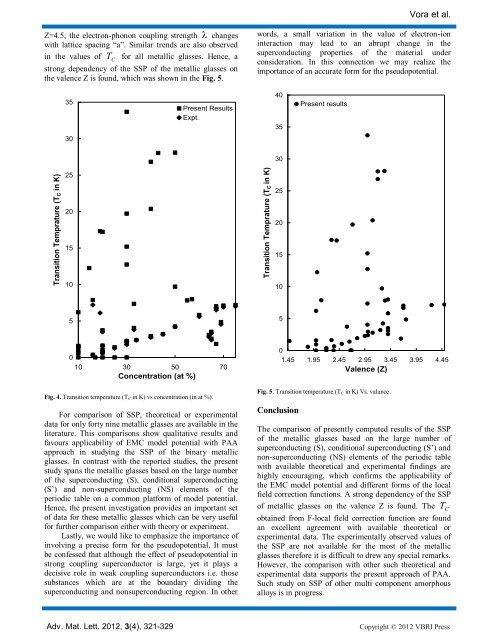Superconducting state parameters of binary metallic glasses
Superconducting state parameters of binary metallic glasses
Superconducting state parameters of binary metallic glasses
Create successful ePaper yourself
Turn your PDF publications into a flip-book with our unique Google optimized e-Paper software.
Z=4.5, the electron-phonon coupling strength λ changes<br />
with lattice spacing “a”. Similar trends are also observed<br />
in the values <strong>of</strong> T C for all <strong>metallic</strong> <strong>glasses</strong>. Hence, a<br />
strong dependency <strong>of</strong> the SSP <strong>of</strong> the <strong>metallic</strong> <strong>glasses</strong> on<br />
the valence Z is found, which was shown in the Fig. 5.<br />
Transition Temprature (T C in K)<br />
35<br />
30<br />
25<br />
20<br />
15<br />
10<br />
5<br />
0<br />
Present Results<br />
Expt.<br />
10 30 50 70<br />
Concentration (at %)<br />
Fig. 4. Transition temperature (TC in K) vs concentration (in at %).<br />
For comparison <strong>of</strong> SSP, theoretical or experimental<br />
data for only forty nine <strong>metallic</strong> <strong>glasses</strong> are available in the<br />
literature. This comparisons show qualitative results and<br />
favours applicability <strong>of</strong> EMC model potential with PAA<br />
approach in studying the SSP <strong>of</strong> the <strong>binary</strong> <strong>metallic</strong><br />
<strong>glasses</strong>. In contrast with the reported studies, the present<br />
study spans the <strong>metallic</strong> <strong>glasses</strong> based on the large number<br />
<strong>of</strong> the superconducting (S), conditional superconducting<br />
(S’) and non-superconducting (NS) elements <strong>of</strong> the<br />
periodic table on a common platform <strong>of</strong> model potential.<br />
Hence, the present investigation provides an important set<br />
<strong>of</strong> data for these <strong>metallic</strong> <strong>glasses</strong> which can be very useful<br />
for further comparison either with theory or experiment.<br />
Lastly, we would like to emphasize the importance <strong>of</strong><br />
involving a precise form for the pseudopotential. It must<br />
be confessed that although the effect <strong>of</strong> pseudopotential in<br />
strong coupling superconductor is large, yet it plays a<br />
decisive role in weak coupling superconductors i.e. those<br />
substances which are at the boundary dividing the<br />
superconducting and nonsuperconducting region. In other<br />
Vora et al.<br />
words, a small variation in the value <strong>of</strong> electron-ion<br />
interaction may lead to an abrupt change in the<br />
superconducting properties <strong>of</strong> the material under<br />
consideration. In this connection we may realize the<br />
importance <strong>of</strong> an accurate form for the pseudopotential.<br />
0<br />
1.45 1.95 2.45 2.95 3.45 3.95 4.45<br />
Valence (Z)<br />
Adv. Mat. Lett. 2012, 3(4), 321-329 Copyright © 2012 VBRI Press<br />
Transition Temprature (T C in K)<br />
40<br />
35<br />
30<br />
25<br />
20<br />
15<br />
10<br />
5<br />
Present results<br />
Fig. 5. Transition temperature (TC in K) Vs. valance.<br />
Conclusion<br />
The comparison <strong>of</strong> presently computed results <strong>of</strong> the SSP<br />
<strong>of</strong> the <strong>metallic</strong> <strong>glasses</strong> based on the large number <strong>of</strong><br />
superconducting (S), conditional superconducting (S’) and<br />
non-superconducting (NS) elements <strong>of</strong> the periodic table<br />
with available theoretical and experimental findings are<br />
highly encouraging, which confirms the applicability <strong>of</strong><br />
the EMC model potential and different forms <strong>of</strong> the local<br />
field correction functions. A strong dependency <strong>of</strong> the SSP<br />
<strong>of</strong> <strong>metallic</strong> <strong>glasses</strong> on the valence Z is found. The C<br />
T<br />
obtained from F-local field correction function are found<br />
an excellent agreement with available theoretical or<br />
experimental data. The experimentally observed values <strong>of</strong><br />
the SSP are not available for the most <strong>of</strong> the <strong>metallic</strong><br />
<strong>glasses</strong> therefore it is difficult to drew any special remarks.<br />
However, the comparison with other such theoretical and<br />
experimental data supports the present approach <strong>of</strong> PAA.<br />
Such study on SSP <strong>of</strong> other multi component amorphous<br />
alloys is in progress.
















